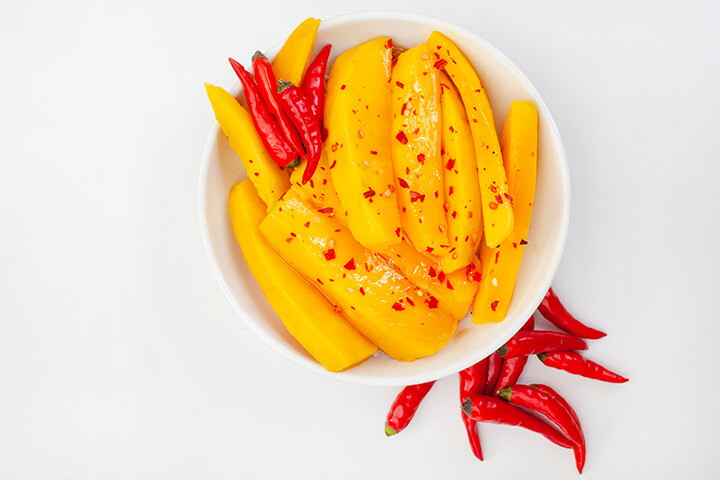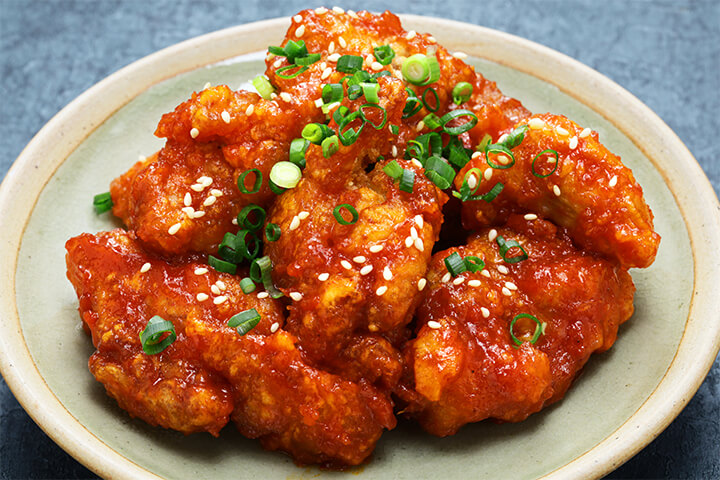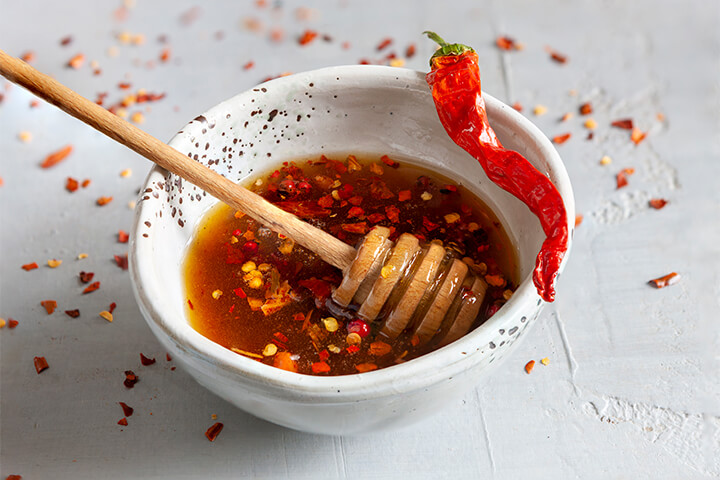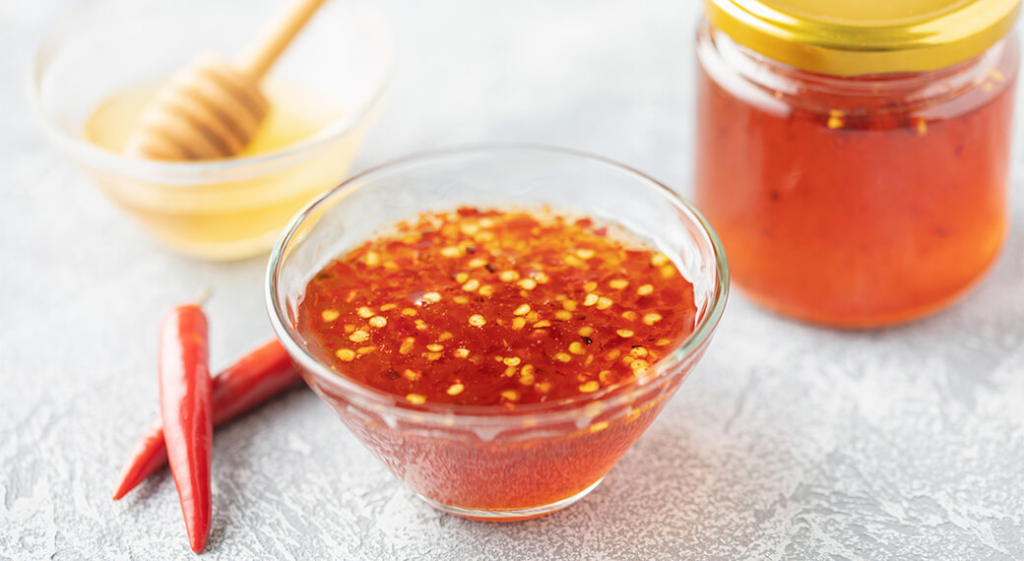Analysts predict that the swicy (sweet + spicy) trend will continue gaining momentum in 2025. Although it is being heavily marketed as a new trend, the swicy flavor profile isn’t a fleeting fad; it’s a deeply ingrained human preference for balanced sensory experiences and a ubiquitous part of global cuisine.
For foodservice and beverage operators eager to capitalize on this flavor profile, here’s a deeper look into the world of swicy cuisine.
How a New Name Is Driving a Beloved Flavor Profile

While “swicy” isn’t a new flavor profile, the term itself is relatively recent. Creating a new, novel term allows marketers to build a sense of excitement and discovery around a familiar taste. Moreover, by giving it a catchy name, they can package it as a trend, driving consumer interest and purchasing behavior.
Sweet and spicy combinations have been a staple in various cuisines for centuries, especially in Asian or Latin countries. For example, in Mexico, mole sauces often incorporate both sweet fruits and chili peppers, creating a complex and balanced flavor profile. Beverages like Mexican hot chocolate offers sweetness with a kick. Or think of the classic mango and hot sauce pairing.
The marketable appeal of swicy lies in the balance and complexity it offers. The sweetness tempers the heat, while the spice enhances the perception of sweetness.
Swicy Strategies for Restaurants and Bars

For forward-thinking restaurants and bars, simply sprinkling chili flakes on a dessert is an oversimplification of the “swicy” opportunity which has evolved to encompass a broader spectrum of flavor and heat levels. Here are some concepts to consider when adding more swicy items to your menu.
To truly resonate with the discerning palate, consider the concept of “flavor architecture“: the deliberate and structured way in which flavors are combined and layered to create a complete and satisfying sensory experience. Deconstructing the sweet and spicy poles as spectrums of intensity and texture creates dynamic and evolving flavors in a dish.
For the mixologist, a cocktail might juxtapose the tang of fresh fruit with a ghost pepper-infused syrup, creating a layered interplay that builds anticipation with each sip.
Understanding the psychological underpinnings of the “swicy” appeal is also important. The sweet element provides a sense of familiarity and comfort, while the heat evokes a controlled thrill. Manipulating these contrasting sensations in a thoughtful way results in dishes and drinks that are both comforting and thrilling.
Trending Spicy Ingredients to Consider

Below are examples of up-and-coming or newly popular ingredients in the US market that patrons are on the hunt for and operators are finding success with.
Gochujang
This Korean fermented chili paste is already quite popular, but its versatility continues to drive its presence in Western cuisine. Gochujang offers an addictive combination of sweet, spicy, savory, and umami flavors. It’s incredibly versatile, working well in sauces, marinades, and dips that extend far past Korean cuisine.
Restaurant/Bar Application Examples: Gochujang aioli for burgers or fries, gochujang-glazed wings, pork belly, or salmon, gochujang in cocktails for a spicy kick, gochujang dipping sauces. For desserts, this flavor profile works surprisingly well with caramel.
Calabrian Chili
Fresh from the Calabria region of Italy, Calabrian chili peppers are gaining traction for its fruity heat and depth of flavor. Calabrian chilies have a more nuanced heat effect than some other peppers, with a slightly smoky and fruity profile that pairs well with sweet ingredients.
Restaurant/Bar Application Examples: Add Calabrian chilies to agrodolce sauce for depth of flavor, Calabrian chili honey as a dynamic add-on for pizzas or cheese boards, Calabrian chili oil for pasta dishes, Calabrian chili in a spicy margarita, or pair it with chocolate for swicy desserts.
Hot Honey
While hot honey itself is established, many variations are emerging. It’s the perfect time to make a statement by creating your own in-house recipe. Hot honey is a simple yet effective way to add a swicy element.
Restaurant/Bar Application Examples: Infuse honey with less common peppers like pimientos de Padrón or aji amarillo for a distinctive heat. Also, consider smokiness. Smoked and charred foods are also becoming more popular with the tantalizing edge they bring to a plate. Merge the two trends by smoking the honey before infusing it with chilies. And don’t forget about herbs. Combine honey with herbs like rosemary or thyme for complex flavors that satisfy. Health-based establishments can concoct an exquisite medicinal blend using hot honey and herbs for beverage applications.
Yuzu Kosho
This Japanese condiment made from yuzu peel, chili peppers, and salt is gaining wider recognition in the US market. Yuzu offers a citrusy aroma and flavor that complement the heat of the chilies. Its bright and refreshing character can be seamlessly integrated into fusion cuisine menus. We recommend starting with a small amount, as this condiment can be quite potent.
Restaurant/Bar Application Examples: Chicken and pork with yuzu kosho marinade, yuzu kosho aioli, yuzu kosho vinaigrettes for salads or bowls, yuzu kosho in cocktails for a citrusy-spicy twist.
Join the Swicy Conversation

Swicy flavor profiles, a tried-and-true joy around the world, offer creative chefs and mixologists untethered experimentation and innumerable flavor combinations. What’s your preferred chili to use in swicy concoctions? Let us know in the comment section!



